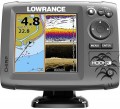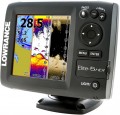Total radiation angle
The angle covered during operation by the transducer of the echo sounder (or an instrument with such a function, see "Type").
Technically, the
wider the angle, the better the echo sounder is suitable for finding fish and other underwater objects, because. a large coverage area reduces the likelihood of missing prey. On the other hand, to accurately determine the depth, the beam must be as narrow as possible. This is due to the fact that the depth is determined by the maximum protruding point that fell under the beam; thus, if the size of the hole at the bottom is smaller than the spot from the beam, the device simply will not notice this hole. The smaller the angle (and, accordingly, the projection of the beam onto the bottom) — the less likely this phenomenon is.
However, it should be taken into account that all of the above is unambiguously true only for single-beam echo sounders (see "Number of radiation beams"). But multibeam models, usually, combine beams of different widths, thus compensating for the shortcomings of narrow and wide angles. In them, the total radiation angle describes only the dimensions of the space covered by the device.
Emitter power
The power output by the fishfinder (or fishfinder-chartplotter, see "Type") when operating.
The
more powerful the emitter, the more “long-range” the device turns out, the greater the depth at which it can work normally (see above). However, do not forget that the practical capabilities of an echo sounder depend on a number of other parameters, ranging from operating frequencies and angles (see above) to the quality of the receiver and the features of signal processing algorithms. In addition, different manufacturers may indicate different types of power in the characteristics: in some cases it is peak (maximum power at the time of a single pulse), in others it is RMS (rms power calculated over a certain period of time and obtained below peak). Therefore, we can say that the role of this parameter is usually purely reference, and when choosing, it is worth focus on moments that are closer to practice (for example, the same scanning depth).
CHIRP Technology
Sonar support
for CHIRP technology.
The meaning of this technology is to use the echo sounder at the same time several frequencies. In other words, each pulse consists of several signals, each at its own frequency. According to the creators, this allows you to improve image quality, increase detail (including at great depth and high speed) and at the same time reduce the level of noise and other interference on the screen compared to single-frequency sonars. However, models with CHIRP are noticeably more expensive.
Functions
—
3D maps. Support for maps rendered using 3D graphics. This provides additional visibility in the work: the relief on the screen can be seen not in the form of conditional lines and colour spots, but in the form of protrusions and depressions, the shape of which most closely matches the real shape of the surface. In this case, the three-dimensional image can be supplemented with colour and/or numerical indication to clarify additional data (for example, specific depth values). This feature is typical for high-end models with the chartplotter function (see "Type").
— Sound alarm. The presence of an audible alarm in the design of the device. The types of alarms and their triggering situations can be different: fish detection, critical depth reduction (see
“Shoal/Shoal” below), reaching a checkpoint,
man overboard(see below), etc. However, anyway, this type of notification is more reliable than graphic indication on the screen — the user does not have to look at the device to hear the sound. This greatly reduces the risk of missing an important message.
—
Determining the distance to the fish. Ability to determine the distance to the fish detected by the echo sounder. Usually, we are talking about the distance in depth, and the indication itself can be carried out in different ways: in some models, fish marks are displaye
...d opposite the depth scale, in others, a specific value can be given for each mark separately.
— Indication of symbols in the form of fish. The ability to display on the screen a signal from a fish detected by an echo sounder in the form of, in fact, “fish” icons. This option is better suited for non-professional users than standard icons in the form of arcs of various shapes: working with arcs requires some practical knowledge to distinguish fish from other signal sources, and in the case of “fish”, the device itself solves this task for the user. Of course, no such system is perfect, and therefore false positives are not ruled out; on the other hand, recognition technologies are constantly improving. Many echo sounders with this function even have a gradation according to the size of prey — large, medium, small.
— Indication of fish in real time. In devices with this function, fish signals are displayed on the screen when a fish enters the echo sounder beam — and disappear when it leaves the beam. This allows you to track the movements of potential prey as quickly as possible and evaluate the prospects of a particular location — while models without real-time indication display marks constantly, upon detection of fish, and make it difficult to assess its movements.
— Fast screen refresh. The refresh rate of the echo sounder screen determines how evenly the relief “visible” by the device is drawn on this screen. This parameter is important when moving at high speed: if the screen is updated slowly, there is a high probability of the appearance of "steps" with sharp drops — due to the fact that the device did not have time to process and display data on the bottom section passed. By “fast” update is meant a mode that allows you to comfortably use the echo sounder at high speed; for different manufacturers, the specific values \u200b\u200bof this speed may vary, however, usually, we are talking about at least 30 – 40 km/h, developed by powerful motor boats.
— Shallow water/shallow. This function provides an indication of a critical decrease in depth, fraught with grounding with all the associated unpleasant consequences. The depth at which the alarm is triggered can most often be set at the request of the user.
— Automatic change of depth scale. Automatic change of scale of the image on the screen depending on the depth "seen" by the echo sounder. This function adjusts the screen of the device so that the entire scanned volume of water from the surface to the bottom is completely visible on it, and it is not necessary to move the image up and down to assess the situation. For example, at depths of 35-40 m, a model with auto-zoom can use a 50-metre scale, and when reaching greater depths, switch to 80- or 100-metre, at smaller depths, to 20-metre, etc. At the same time, automatic adjustment "makes life easier" for the user, eliminating the need to adjust the scale manually.
— Displayed depth range. The ability to manually set the device to a specific depth range shown on the display — so that the space above and below this range will be outside the screen. This function can be useful, for example, to search for fish walking in a certain depth range; while limiting the range allows you to get an image on a larger scale than when viewing the entire space from the surface to the bottom.
— Determination of bottom density. The ability to use an echo sounder to determine the density of the bottom surface. A device with this function allows you to determine what is under the vessel — stone, sand or soft silt; this information may be useful when catching some types of fish. In addition, bottom density data is useful when searching for underwater objects — for example, sunken ships are often distinguished by "hard" spots on a soft surface.
— Indication of water temperature. Possibility to display the water temperature on the device screen. The specific features of such an indication can be different: some models show only data on the water in direct contact with the sensor (that is, in fact, the temperature on the surface), others are also able to display data on the thermocline (temperature jump layer).
— Indication of speed. The ability to display the speed of movement on the screen of the device. This feature provides additional information and can be useful even on boats equipped with their own speedometers — getting speed data directly on the sonar / chartplotter screen is often more convenient than being distracted by a separate device. This data can come from different sources — for example, from a GPS module or from a specialized sensor (log).
— Display of the distance traveled. The ability to display the distance traveled on the screen of the device. Features of this function may vary depending on the model: in the simplest devices only the total distance traveled is shown, more advanced ones (usually with a chartplotter function, see "Type") can also draw the route on the map.
— Function "man overboard". As the name suggests, this feature facilitates rescue operations in the event of a person falling overboard. The specific functionality associated with this may vary in different models, but usually there is at least the ability to quickly fix the scene in the device and switch it to the navigation mode to this point. And in more advanced models, DSC maritime radio communications may also be provided, as well as the reception and processing of similar signals from other ships.Key backlight
The presence of a
key illumination system in the design of the device.
The role of this function is similar to the backlight of the display (see "Display"): it makes the keys visible even in complete darkness, allowing you to accurately control the device's functions. Yes, even in twilight conditions, the backlight can come in handy — not all buttons have markings that are clearly visible in low light.
Power source
The supply voltage required for the normal operation of the device. This parameter allows you to determine compatibility with the intended power supply.
Note that usually a certain voltage range is indicated in this paragraph, which ensures versatility. Of course, it is impossible to go beyond this range: too low a voltage can simply “not start” the device, and too high a voltage can damage the electronics. And even seemingly normal operation with a “non-native” voltage (for example, when an unsuitable power source is accidentally connected) is not an indicator in this case: an abnormal mode anyway will accelerate the failure of the device, and besides, it can lead to displaying incorrect readings .

